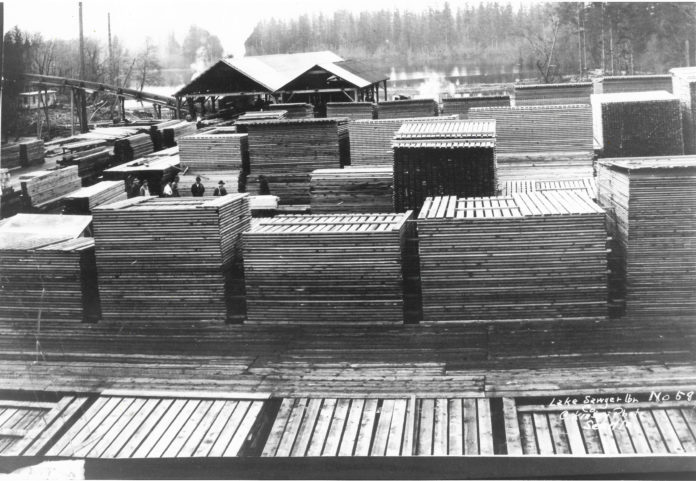Recent area forest fires call to mind a logging slash blaze that scarred scores of acres north of Black Diamond in the 1930s. The slash resulted when thousands of acres surrounding Lake Sawyer were logged. At the time there were no homes so little damage resulted. In fact as has occurred for millennia, a Douglas fir forest soon took root on the charred grounds. The logging was primarily due to a new sawmill constructed on the northeast peninsula of the lake by the fittingly named Lake Sawyer Lumber Co. The company was incorporated on Sept. 20, 1919 by Joseph and John Neukirchen, who previously operated milling and logging operations in Issaquah. Seeking new sources of timber the Neukirchen brothers commenced their Lake Sawyer mill operation in April 1922.
The enterprise was extensive with 4.5 miles of small-gauge railroad constructed through area forests with one locomotive and four flat cars transporting logs to the lake. The rails extended as far east as Ginder Lake and west to Lake Morton. The westerly line featured an impressive log dump extending more than 150 feet into Lake Sawyer allowing a dramatic splash as timber fell from railcars to water where a barge floated logs to pens in the north cove west of the mill site. A remnant of that log dump is now a 4,000 square foot island with connecting pedestrian bridge located at the Lake Sawyer RV Park owned by Sunrise Resorts.
Every mill needs an ample stockpile of ready timber. Storage in the lake kept the logs fresh and provided an easy method for pulling them into the mill before wheel loaders and forklifts made simple work of moving heavy items. After sawing and planing the resulting dimensional lumber was hauled by a short spur to Northern Pacific’s nearby mainline. The company typically employed about 30 men, seven of whom are visible in the left center standing among cut lumber. Employment peaked at 45 around 1927. By 1934, the mill closed succumbing to either the Great Depression or absence of readily available timber.
Today the former site is occupied by million-dollar lakefront homes with no trace of the mill remaining. This westerly-looking, 1928 photo #58 by Clark Kinsey comes courtesy of JoAnne Matsumura, an Issaquah historian. Facts about the mill were derived from Peggy Hawkins, granddaughter of Joseph Neukirchen and a series of posts written in Black Diamond Now by the late Craig Goodwin who died tragically last month.








